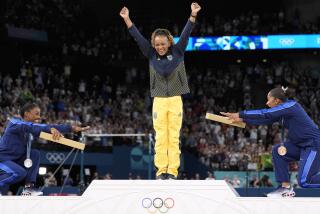Bailes Gets Just Deserts, Not Dessert
- Share via
SEATTLE — It couldn’t be happening again .
The doctors had found what was wrong with Scott Bailes, and when they told him he had low blood sugar and could no longer eat ice cream--”my favorite food in the world,” he moaned--he willingly made that sacrifice to regain his health and salvage his pitching career.
With a new diet, the Angel left-hander felt strong and determined to show he could pitch better than last season, when his 6.37 earned-run average earned him a trip to the Angels’ triple-A team in Edmonton.
But when he walked San Diego’s Greg Gross, the first batter he faced in his first exhibition game this spring, it seemed Bailes’ nightmare was starting again.
Not to worry.
“Doug Harvey, the old National League umpire, handed me the ball and said, ‘You should be able to get somebody out with this,’ ” Bailes said, running his finger along a baseball to show where it had been cut; in the informal games of spring, umpires aren’t as quick to remove such a ball from play. “It was going all over the place. I said, ‘Forget this. I need a different ball.’ ”
With regulation equipment, and with the fuzzy days and long nights of his illness behind him, Bailes was a different and impressively effective pitcher this spring. Manager Doug Rader had deemed him a longshot to make the club, odds Bailes defied when he gave up one run in 13 1/3 innings.
“He’s come a long way,” Rader said of Bailes, who pitched 1 1/3 scoreless innings in his first regular-season appearance Wednesday night in Seattle. “He’s got a much better handle on himself and his stuff.”
Controlling his hypoglycemia was the key to Bailes’ comeback. Bailes, who was acquired from Cleveland in January, 1990, for minor leaguers Jeff Manto and Colin Charland, had always been slender. When he kept losing weight and was down to 165 pounds from his usual 185 after his Edmonton exile, it was obvious something was amiss.
“I couldn’t believe how skinny he was,” said fellow reliever Mark Eichhorn, who struck a friendship with Bailes when both joined the Angels last season. “He looked awful.”
That matched the way he felt. Bailes became nauseated, groggy and unable to concentrate on the mound. His performance soon suffered. Bailes had a 2.91 ERA on May 24, but that zoomed past 3.00 in early June and past 5.00 by early July. He had given up 17 hits in his first 21 1/3 innings, but was pounded for 29 in his next 13 2/3 innings.
“It started in June, and I went through the whole year with it until I got home,” said Bailes, who operates a driving range and baseball school in his hometown of Springfield, Mo. “I knew something had to be wrong. I’m a guy who usually sleeps six, seven hours a night, and I was sleeping 12 or 13 and I was tired all the time. I went to the doctor and he asked me, ‘What do you want me to check?’ I said, ‘Everything you can.’ I went through a two-day physical.”
That battery included a glucose tolerance test, a six-hour procedure that measures the body’s ability to maintain a proper level of sugar in the blood system.
“They give you a bunch of sugar and you drink it and they measure (the level) every hour,” Bailes said. “After the third hour, I got up out of the chair and fainted. I tested real low, to the point of where I could have gone into a coma.
“They say at a level of 40, whatever that is, you go into a coma. My number was 42.”
Ice cream and sugary soft drinks are forbidden, but Bailes has been rewarded for his dietary diligence. Physically stronger, he more nearly resembles the confident rookie who won 10 games for Cleveland in 1986 than the befuddled, lost soul he was last season.
“I have a lot more energy, which I think converts on the mound to pitching more aggressively,” Bailes said.
“Last year, it really affected my concentration. I’d be out there in a fog. I’d be behind and try to make perfect pitches on 2-and-0 and 3-and-1 counts. I pitched ahead to every hitter this spring, and that’s my main goal this season. If I get hit, I’ll get hit, but I want it to be on my best pitch and for me to be ahead in the count. . . .
“This (was) my sixth opening day, and except for my rookie year, this is the most satisfying. I had the most (distance) to come and the most to prove this year. I feel good about what I did this spring and I really want to take it into the season.
“I’m not going to have a no-run season, but I want to get the respect of the team. I got it back from the coaches, but during this season I want to get the respect of the team.”
More to Read
Go beyond the scoreboard
Get the latest on L.A.'s teams in the daily Sports Report newsletter.
You may occasionally receive promotional content from the Los Angeles Times.







